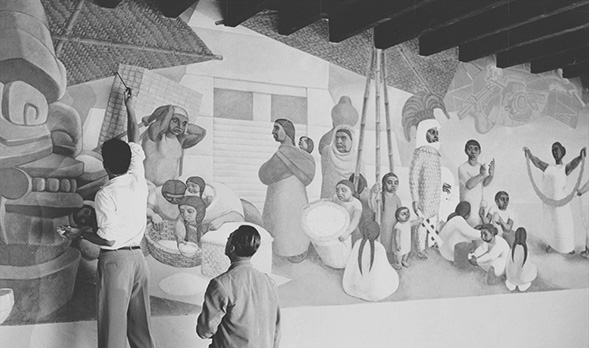SDSU Mural Connects Modern Mexicans With Aztec Ancestry
The preservation of a historic "market" mural is in its beginning stages.

Among the oldest structures on the San Diego State University campus is the Exercise and Nutritional Sciences (ENS) complex. At its center is a quad featuring a beautiful but long-dry fountain amid a series of staircases and doors.“I think it is a strong statement of everyday life and reverence for the past.”
In the quad’s northwest corner is an entrance to a small foyer presenting doors to three rooms: a dance studio, a restroom and a meeting room. They are uniformly unremarkable on the outside, but the scene behind the meeting room door is astonishing.
The space is dominated by a colorful mural running the length of the room. “Market,” as the painting is called, depicts 23 figures at an ancient marketplace engaged in various activities against a backdrop that includes images of an Aztec temple and deity.
As a small plaque explains, the mural was painted in 1949 by art student Robert Hugenberger (’49) under the instruction of art professor Lowell Houser. As other murals on campus were destroyed by new construction or painted over during remodeling projects, “Market” survived for seven decades, largely unscathed due to its relatively secure location behind a locked door in an infrequently visited room.
Prompt need for preservation
ENS faculty and staff now regularly use the room for meetings, but current plans call for it to be updated as a space for teaching assistants and other purposes. Remodeling will require removal of asbestos and lead-based wall paint, posing a possible threat to the mural.“Because more things will be going on in here, we want to make sure we protect the mural,” said Matthew Mahar, director of the School of Exercise and Nutritional Sciences. To that end, Mahar contacted University History Curator Seth Mallios, who has led the effort to preserve other historic murals discovered on the SDSU campus.
Mallios believes the mural is significant because it combines the Mexican muralist tradition with the post-World War II fantasy and escapism of the late 1940s and early 1950s. The imagery, he said, unites modern Mexicans in the marketplace with their Aztec ancestry as pre-Columbian gods mysteriously float through the sky and stand in their midst.
“I think it is a strong statement of everyday life and reverence for the past,” Mallios said, adding that the subject matter and presentation reflects a prevailing student mindset of the time. He also cites the mural as an example of a talented student artist engaged in producing “real art” early in his career.
“This isn’t just an empty homework assignment,” Mallios said. “This is a beautiful piece of art by a very talented individual who would go on and use these tools that he was crafting here.”
Damage assessment
To determine the best approach to preserving the mural, Mallios called Gary Hulbert, a widely respected conservator who has restored and preserved several of SDSU’s historic murals and whose work includes restoration of some of the famous Hearst Castle’s art. During a visit to campus earlier this month, Hulbert assessed the status of “Market.”“In general, the mural is in good shape,” Hulbert concluded after closely examining the 27-by-8-foot work. He noted there is some water damage caused by a leak near a fireplace abutting the painting, “but nothing major structurally wrong with the mural.”
Previous work to update the room caused some damage to an upper portion of the mural near the ceiling. A few areas of cracking paint are also a concern.
The mural’s information plaque states an experimental “encaustic” medium was used, consisting of powdered pigment mixed with melted wax and turpentine. “So one has to take care how to come up with a conservation treatment that will not harm the original paint,” Hulbert said.
“Each project is unique and has its own challenges, so it’s going to take a little more investigation. Sometimes as you work on a mural project, you will find new things that will crop up.”
Mahar said the next move will be to devise a plan to begin remodeling without causing any additional damage to the mural. The ENS staff will await Hulbert’s recommendations before proceeding.
You can support the historic “Market” mural preservation by making a donation of any amount at SDSU STRIVE.



